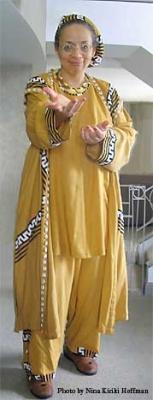Science fiction and fantasy writer Nisi Shawl is best known for her short stories, such as the ones contained in Tiptree award winning Filter House. But Shawl’s recently turned her attention to steampunk and is currently working on a steampunk novel, Everfair, set in the Belgian Congo.
She says of it, “Everfair was a dare I gave myself. In 2009 I attended World Fantasy and was assigned to appear on the ‘Why Steampunk Now?’ panel with Ann and Jeff VanderMeer, Michael Swanwick, Liz Gorinsky, and Deborah Biancotti. Which got me wondering how come I didn’t much care for the stuff. I’ve loved reading early British fiction for decades, and old metal implements get me all moist, so steampunk ought to have been my speculative subgenre of choice, right? But the pro-colonialism, the implicit—and sometimes explicit—backing of Britain’s Victorian Empire? That, I simply could not stomach. Though I searched, I found very few examples of what Doselle Young calls ‘cotton gin punk,’ but the intersection of people of color and industrial technology seemed a natural one to me. So during the panel, after pointing out some ways to make the subgenre more inclusive, I announced to everyone in the room that I was going to write a steampunk novel set in the Belgian Congo. Swanwick rolled his eyes and grimaced, whereupon I added ‘and I will make you beg to read it!’
“Then I had to figure out how to turn one of the worst human rights disasters on record into a book that would seduce an audience away from films, TV shows, Twitter—not to mention other books. A chance discovery of the history of Henry Ford’s failed corporate South American colony, Fordlandia, gave me my model. The book’s title, “Everfair,” is the name of an imaginary Utopia set up on land purchased from the Belgian Congo’s ‘owner,’ King Leopold II. In my novel, Britain’s Fabian Socialists join forces with African-American missionaries to make the purchase using funds that in real life endowed the London School of Economics.”
Everfair is told from a multiplicity of voices: Africans, Europeans, East Asians, and African Americans. In facing the challenge of multiple point-of-view characters in complex relationship with each other, Shawl found she had a talent for representing such a diverse range of voices, although she noted, “It’s certainly a challenge, though, to represent voices that have been silenced. The indigenous people of the Congo region were killed by the millions. Survivors are few, and entire cultures have vanished. Reconstructing that? It’s work, all right. Three characters come from this background: Fwendi, whose hand was chopped off by rubber bosses when she was a child; Josina, a woman educated by white invaders, and Mwenda, a king whose country has been claimed by Leopold.”
The most appealing voice among the throng for Shawl was that of Lisette Toutournier, a character modeled on Colette. “That’s probably because I adore her real-life counterpart. I’ve read so many of Colette’s books and memoirs, trying even before Everfair to absorb the elements of her style, which I’d dearly love to emulate. Those who have read what I’ve written of the novel so far like Lisette’s sections the most; they say they leap to colorful life. I guess my fondness for that voice shows.”
Shawl enjoys steampunk that’s “doing it right.” She recommends Shweta Narayan’s work, particularly “The Mechanical Aviary of Emperor Jalal-ud-din Muhammad Akbar” (Shimmer, December 2009). For someone starting out, there’s a series of anthologies edited by JoSelle Vanderhooft. There are two volumes so far of Steam-Powered: Lesbian Steampunk Stories, and though the emphasis is on marginalized sexuality, there’s great racial diversity within the TOCs, and lots of anti-imperialism and postcolonialism among the settings and storylines. N.K. Jemisin’s “Effluent Engine” was first printed in Steam-Powered 1, and Shawl has an excerpt from “Everfair” in Steam-Powered 2, along with pieces by Stephanie Lai and Amal El-Mohtar. For someone allergic to short stories, someone who simply must have a novel and can’t wait for Everfair’s publication, she recommends Cherie Priest’s Boneshaker. Also, two websites: beyondvictoriana.com, run by Ay-leen the Peacemaker; and silver-goggles.blogspot.com, run by Jaymee Goh.
As the genre continues to grow, she doesn’t want to see steampunk used in some of the ways it may have presented itself in the past. “Apologia for colonialism. Thoughtlessness. Sexism. Unconscious assumption of white privilege. Or, come to think of it, conscious assumption of same. The sort of erasure of work and the people who do it that Ursula K. Le Guin lamented in fantasy when she wrote ‘From Elfland to Poughkeepsie.’”
Shawl has talked in the past about Suzy McKee Charnas’ novel Walk to the End of the World as the book that encouraged her to write speculative fiction. The book struck a chord. “Walk to the End of the World takes a horrendous scenario, extrapolates realistically from it, and yet offers hope. Everfair does the same, though till you asked me I’d never realized the similarity. The horror Charnas is writing about is a post-apocalyptic continuation of the worst hierarchicalist misogyny bureaucracy has to offer. The horror I write about is something that really happened: millions of deaths and maimings, which I envision as being averted due to a slightly different course of history featuring dirigibles. Physically plausible dirigibles.”
Cat Rambo’s latest collection, Near + Far, is available from Hydra House Books. Find links to her online fiction at http://www.kittywumpus.net












I soooo look forward to reading Everfair!
Thanks, for a fantastic post, Cat!
Possibly it’s just loose terminology in this case, but one thing that always really, really ticks me off as a student of African history is confusing “The Congo Free State” (1884-1908) with “The Belgian Congo” (1908-1960).
This is not merely a semantic distinction.
The Congo Free State was NOT ruled by the Belgian government.
It was established and ruled by Leopold, personally, who also happened to be Leopold II, (constitutional) king of Belgium.
Before it started making money, he tried to unload it on Belgium, but successive Belgian governments refused to have anything to do with it. Leopold (who had a bee in his bonnet about colonies) tried repeatedly to get the Belgian government involved in acquiring overseas possessions, and failed totally.
Belgium was a small, neutral, very prosperous European country and simply not interested. Everyone in Belgium outside Leopold’s personal entourage (and some within it, though not to his face) thought he was nuts, an embarassment who’d blow through all his money and go broke but who had to be humored for PR reasons.
Leopold was a constitutional monarch in Belgium; he had about as much political power there as Queen Victoria did in Britain, which wasn’t much.
He built up the Congo Free State with his own money and with mercenaries (African and European) working directly for him; like Stanley, aka “Bula Matadi”, the “Rock Crusher”.
After repeated near-bankruptcies, in the early 20th century the Congo Free State became one of the few African colonies of the era which actually made a lot of money, which Leopold spent lavishly in Belgium in the (quite futile) hope it would make him popular.
When the lid got blown off the “red rubber” scandal, this profit turned out to be the result of Leopold’s goons extorting and slaughtering to get the locals to turn over rubber for, essentially, nothing except “not getting beaten, mutilated or killed (this time)”.
The loss of life was exaggerated later, but was nevertheless quite heavy, probably about 20% of the overall population and more in the zones where the pressure for rubber was greatest. It’s impossible to be certain because there are no accurate statistics available.
There were proportionately worse episodes in the period (the Herero revolt in German South-West Africa, for one, with its “extermination order”) but not many, and this was probably the worst in absolute numbers because there were a lot more people in the Congo.
This was, incidentally, initially discovered (and exposed) by a guy named E.D. Morel, working in a Liverpool import-export firm with longstanding connections with the Congo, who looked at the books in detail and noticed that a lot of stuff was coming out of the Congo Free State (ivory, palm oil, and a great deal of rubber) but virtually nothing was going in except Albertini rifles and ammunition.
This struck him as skanky, and (to simplify a complex story) he and others who got interested mounted a pressure campaign which eventually forced Leopold to give up the Congo.
Even by the rather rough standards of the day, Leopold’s behavior was regarded as seriously uncool. It was the scandal in the West which put an end to the Free State — the locals couldn’t do anything but die. Though he would have robbed the place bare eventually, in all likelihood.
Leopold was no worse than the immediately preceeding warlords in the slave-trade era in the Congo, like Msiri of Katanga or the Arab-Swahili empire builder Hamad bin Muhammed, known locally as “Tippu Tib” after the sound his men’s muskets made.
Tippu Tib worked for Leopold for a while before retiring to the clove plantations he owned on Zanzibar, worked by around 10,000 slaves at their height.
Those were just the personal human chattels he owned; hundreds of thousands had passed through his hands, and it was conservatively estimated that 5 natives died in the interior or on the road to the coast for every slave that arrived in Zanzibar or Bagamoyo.
You could say that Leopold was worse because he should have known better — did, in fact, since he disguised himself with a lavish dose of nauseatingly humanitarian propaganda.
After the Morel blew the whistle, the Congo became (rather against Belgium’s wishes, because the French and British couldn’t agree on how to divy it up) the -Belgian- Congo, which was for most of its existence a rather normal colonial state of the time, which is to say an authoritarian but not outstandingly bad place.
The post-1960 history of the Congo has been… ah… “not good”.
I wasn’t actually on that panel, only in the audience, and no one on the panel was promoting reactionary fiction of any kind.
Can’t wait to read Everfair! Nisi is a fantastic writer!